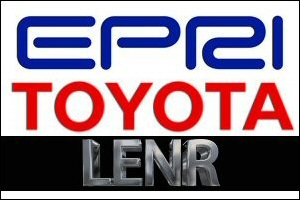EPRI and Toyota Resume Support for LENR Research

Sept. 24, 2012 – By Steven B. Krivit –
[This is the first of a four-part series.]
After a decade-long absence from low-energy nuclear reaction research, the Electric Power Research Institute in Palo Alto, Calif., has sponsored work in the field. Recent LENR work by researchers at Toyota Central Research and Development Laboratories in Nagakute, Aichi, Japan, shows that Toyota also is seriously interested in the field. Another Toyota subsidiary, Technova, has sponsored recent LENR research in Japan.
EPRI is an independent research company that provides technology, policy and economic analyses to its members. EPRI’s corporate members include companies that produce 90 percent of the electricity generated and delivered in the United States; EPRI also has members in 40 countries.
It was a major sponsor of LENR research at Texas A&M University in 1989. It also sponsored a significant LENR research program at SRI International during the 1990s. According to our records and a search of the EPRI Web site, the last EPRI-sponsored LENR research took place in 1999.
However, two weeks ago, New Energy Times obtained a 2012 EPRI report that shows that, beginning in 2009, it sponsored Brian Ahern, an independent researcher based in Boxborough, Mass., to replicate LENR experiments originally developed and performed at Osaka University, Japan.
New Energy Times also obtained new LENR research papers from the Toyota researchers, as well as papers from a separate group at Kobe University that performed LENR research sponsored by Technova.
After “cold fusion” discoverers Stanley Pons and Martin Fleischmann announced their discovery in 1989, the University of Utah and the state of Utah established the National Cold Fusion Institute and hoped Pons and Fleischmann would continue their work in Utah.
Instead, Pons and Fleischmann submitted a research proposal to Technova to work in a new energy research laboratory near Nice, France. Minoru Toyoda, a senior member of the Toyota family, accepted their proposal, and they started there in 1991. According to Bart Simon, author of Undead Science: Science Studies and the Afterlife of Cold Fusion, Fleischmann stayed there until 1995, and Pons stayed until 1998, when the contract with Technova ended and it closed the lab.
The Toyota scientists first presented papers at a LENR conference in 2007. Because they have presented research continuously since then, Toyota clearly has a committed interest in LENRs.
Ahern, the Toyota researchers, and the researchers at Kobe University in Japan have performed and advanced LENR science using the nanomaterial and hydrogen-isotope-gas absorption method. The method was developed by two professors, Yoshiaki Arata and Yue Chang Zhang, at Osaka University. New Energy Times reported on this work in 2008.
The results of these projects have shown a high degree of repeatability, reproducibility and independence. They have also shown consistent results of LENR heat production at low levels and, in some cases, higher rates of heat production.
[Part 2 in this series will publish tomorrow.]
Questions? Comments? Submit a Letter to the Editor.
Sept. 24, 2012, 3:57pm
A reader who wishes to remain anonymous called me and stated that Toyota had an underground LENR research program at least as far back as 2003. The reader said that he met Toyota researchers at ICCF-10 in Boston and that they told him their LENR research program had been active for several years. I checked my registration list for ICCF-10 and confirmed that two Toyota researchers were listed as attendees.
Steven B. Krivit

